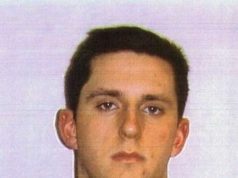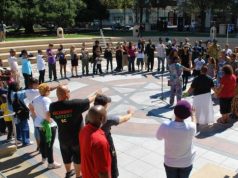
(6/15) — UPDATED 19:55 PDT — LOS ANGELES — Firearms training was in the spotlight Tuesday as experts testified that movements made by former BART Police officer Johannes Mehserle to release the weapon holstered at his right hip were inconsistent with the proper way to draw a gun.
Mehserle is charged with second degree murder for fatally shooting unarmed BART passenger Oscar Grant on New Year’s Day 2009.
Paul Slivinsky, a recently retired BART SWAT officer who examined the weapon Mehserle used to shoot Grant — a Sig Sauer pistol — shortly after the shooting, testified that the gun was “in perfect condition.”
During cross examination by defense attorney Michael Rains, Slivinsky was asked about the safety mechanism of the gun. Slivinsky said the Sig “only has passive safeties,” meaning that there is no thumb mechanism on the side of the weapon that must be pushed upward to discharge it like there is for Tasers.
The defense has argued that in video footage of the incident, Mehserle can be seen swiping his thumb against the side of his gun, an action Rains said indicates Mehserle was trying to remove his Taser.
“There is no reason an officer whose intent is to fire a Sig would have his thumb on the side at all?” Rains asked Slivinsky, who said yes to the question.
Slivinsky testified that he had fired that model of weapon himself “only once or twice.”
Stein then brought to the stand David Clark, a firearms instructor at Napa Valley College’s police academy, from which Mehserle graduated in December 2006.
Clark described safety procedures for the gun and said the main reasons for unintentionally discharging a gun are accidentally putting a finger on the trigger or not being familiar with the weapon.
While Clark did not say whether he had any direct interaction with Mehserle at the academy, he said firearms instructors there teach cadets to “never point a weapon at something you don’t intend to destroy,” and said “officer safety is reinforced daily.”
He described a seven-step procedure the cadets at the Napa Police Academy do “constantly.”
“It takes a long time to build up what we call muscle memory,” Clark said. “It has to be practiced over and over.”
Clark testified that he had never before seen the video he watched today of Mehserle reaching for his holster on his right hip.
Clark said Mehserle’s struggle to release the gun from the holster was inconsistent with police training, as was shooting Grant in such close proximity to another officer and immediately re-holstering his gun after firing the shot.
He also testified that if the perceived threat by Grant was so great, Mehserle should have shot him while still leaning over him, instead of standing back up to do so.
The defense also argues that Mehserle’s struggle with the holster indicates that he was actually trying to deploy his Taser.
Prosecutors contend Mehserle’s difficulty in removing his gun from his holster was because the rookie cop reached for his firearm under pressure from the boisterous atmosphere on the station platform — a point that family members of Oscar Grant agreed with.
“There’s no way Mehserle could have made a mistake because there’s too many steps involved with pulling that weapon out,” said Cephus Johnson, Grant’s uncle, at a press conference after the morning session.
In the afternoon, Stein called training instructor and BART Police Sergeant Eugene Wong to testify on the Koga Method, a set of practices for searching suspects for weapons and issuing arrest, which is used by numerous police agencies including BART.
Wong told the jury that two search and arrest tactics taught to BART Police officers during training — the “kneeling search” and the “prone search” — should only be used in “high risk” situations which “usually involve a weapon.”
In video of the incident, Mehserle and former BART Police Officer Tony Pirone appear to put Grant and his friends in the “kneeling” and “prone” positions.
Members of Grant’s family and friends said the officers were not justified in using such tactics because they did not check to see if weapons were involved.
“The officers never even checked for a weapon that night,” Grant family advocate Rev. Keith Muhammad told the Beat today. “I hope the DA will really go for the slam dunk and stop taking all these soft shots. Everything they did to Oscar was an act of excessive force.”
Wong is expected to continue his testimony in court Thursday, when the trial continues after a scheduled furlough day for Los Angeles County courts Wednesday.
In Tuesday’s morning session, testimony from Grant’s friend Carlos Reyes, who was closest to the unarmed train passenger moments before he was shot, concluded with a series of questions about false statements made to investigators following the incident.
Rains asked Reyes, who was two feet from Grant at the time of the shooting, if he had left the BART train immediately after it stopped at the Fruitvale station platform.
Reyes had testified yesterday that he had done so, but when pressed by Rains today he said he did not remember.
Rains then showed BART surveillance video which appears to show Reyes on the train for at least five minutes after it had stopped at the platform.
“What were you doing on the train? You were fighting weren’t you?” Rains asked.
Reyes responded “No, I wasn’t fighting nobody.”
During opening statements Rains characterized the fight as a brawl between numerous individuals, but several witnesses have testified that the fight was only between Grant and a man named David Horowitz.
Rains then grilled Reyes about his admission that he had lied to BART investigators about whether he was with Grant that night. Reyes testified that “I’m just trying to do what I have to, to never be involved in anything like this again.”
After Rains’ cross examination, Stein asked Reyes what was going through his mind during the BART interview. Reyes said “I was really just thinking about Oscar […] if he was going to be alright or if he was going to be gone.”
Reyes remained handcuffed in police custody for several hours following the early morning shooting before he was interviewed.
Reyes, who was friends with Grant for ten years, fought back tears and said, “You’re so used to seeing police officers protect you […] when you see them hurt somebody you care about, when they shoot someone in front of you, you don’t know what to do.”
Second juror dismissed
Another juror, a middle-aged woman, was dismissed for cause after the break in the morning session. It is believed she was replaced because she kept falling asleep during testimony.
A man from the pool of alternate jurors replaced her. The jury is now comprised of seven women and five men, with four alternate jurors remaining. If a juror is dismissed and no alternates remain, a mistrial would be declared.








